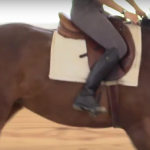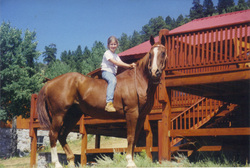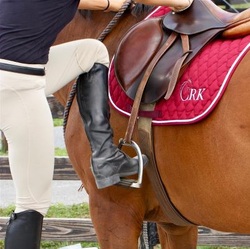I’ve made many changes and improvements to my riding over the years, but if I had to choose just one that has had the biggest impact overall, it was understanding the concept of riding “on my thigh”.
What I mean is allowing my thigh to bear weight, but without tensing or gripping. This is especially important in the movements of posting trot, canter, and when jumping.
Different instructors often describe this feeling in different ways, or use varying exercises to help a rider find the position and feeling. In today’s video, I’ll share a few of these exercises, plus demonstrate this important riding concept.
*I wanted to make a note here about the bit I’m using for Noel in this video – this is a full cheek snaffle by Myler that has the cheekpiece attachment built in to the side of the bit. Not my favorite style, but that is why I am using this full cheek bit without leather keepers. You do need to be careful with full cheek bits as there is a higher possibility of them getting caught.














66 Responses
Thank you very much for this video. My instructor has just recently pointed out to me that my ankles roll out and this is causing my knee and thigh to leave the saddle. I have very flexible ankles and it’s a real struggle to tip them back into proper alignment. However, after the last lesson (which was torture as I concentrated on correcting this issue) my lower back feels much better after the ride.
Do you have any suggestions or helps for this particular problem? Thank you~
Hi! I also have this issue due to a neurological syndrome and have found that angled stirrup pads have made a WORLD of difference. You need the ones that are higher on the outside, not the ones that are supposed to get your heel down.
That was a great tip!! Can’t wait to experiment with it on my horse.
Thanks Callie!
Viviane
The video for this post did not load.
Problem solved.
Thanks so much, Callie. This is a great way to think about where to focus weight/pressure. I’m a novice and still struggling with finding balance in the saddle – especially because I only ride once a week. I’m finding it to be a challenge because I can’t ride frequently enough to develop the muscle memory as quickly as I’d like to. Your riding videos have really helped me to think about my position when I’m home and am trying to understand everything that happened in my lesson.
Love this video. I started to realize this in my last lesson. Once I pointed my toes outward it allowed my heels to drop and I began to feel exactly what this video talks about. In past I was uing my knees to grip.
Thank you for sharing.
Cathy
This is extremely helpful thank you. I definitely ride with my tow out knees rolled out position and need to fix this as my current horse will completely stop all forward movement every time I slip into this position. When I am riding with my trainer she is quick to point this out and I spend a lot of time fixing this – do you have any tips for adults who have slipped into this bad position habit for years as to how we can really work on it when we’re riding alone as well. My canter transitions have really suffered as a result of this bad positioning. I will try the “knees forward and down” suggestion today but could use any additional visual tips you might have for the toe out knees out problem, Thank you!
I love the videos. A better rider in seven days, visualization have all been such a great help for me returning to riding after not riding for years. I have done alot of visualization and my canter yesterday was very much improved along with more relaxation and attention to movements. I will definitely try riding on the thigh. I am so thankful that I found your videos.
Loved this video. It makes a lot of sense and the descriptors you used are easy to visualize. Wish you would have shown more in the canter.
I still have to focus on my thighs every day I ride, and have several little exercises I do when I first get on and sporadically to re-balance and rearrange my wonky body as needed. Angelo’s winged victory is one; I also reach back from the rear of my leg and rotate my thigh inward to snug it against the saddle.
Great video, Callie! The ankle roll out is an issue for a lot of new riders. “Thighs in” is something I am often calling out to my students. Your explanation helps demonstrate in yet another way how important a concept this is!
Love this video! It makes perfect sense. I can’t wait to try it out when I ride next. I tend to lean back so keeping my legs back will help my body to stay in a better vertical position.
Outstanding video and explanation. Wendy’s “knees forward and down” has made a world of difference in my riding. Before, I “tried” to move with my horse, which often interrupted his natural rhythm. Now, by riding on my thighs, I “allow” myself to move with my horse. I feel for an ever-so-slight pull from the top crease at my thighs to my knees and I know I am “forward and down”. I feel my horse’s back come up beneath my seat and he moves more smoothly. This lesson alone was worth the price of her course.
Your comment was well stated and helpful.
Thank you.
I enjoyed your instruction greatly and showing the movement was helpful. Im loose my balance easily. Also have a question unrelated to riding and it is do you have any advice on how to stop or train a horse not to pull back jerking and pulling till he breaks the lead rope. I have used the lasso around his waist and desensitize him as well but he cont to do this bad habit. Any suggestions would be appreciated. Thanks, Kathy
Get help from a professional. I’d suggest someone certified in some sort of “natural” horsemanship. It sounds like there is more than one problem here. My horse and I have a totally new and much more respectful relationship since I’ve incorporated this type of ground training into our regular training. It really makes a difference!
I have to use bungee ties for my horse because of he is “dead tied” he pulls until the leadrope breaks, then just stands there. The same theory might help you. The bungee cross ties seen to have stopped this habit.
What about the knees ? Most of instructors insist a lot about the knees not (or the least possible) touching the saddle, and it seems impossible to have a good contact with the thigh without having a similar quality of contact with the knees ?
Thanks Callie you always provide such informative information. Love your balanced riding course!!
I’m not sure if I am already riding this way or not. Can’t wait to try and make corrections. I gave a horse that’s very sensitive, so can be pretty reactive. A secure seat is a must. Thank you!
Outstanding video! I watched and had an Ah Ha! moment. As an instructor, sometimes it’s hard to verbally explain a correction to a young rider so that they understand completely. This morning, with my youth rider, instead of reminding her to keep her lower leg back, I explained the weighting of the thighs and knee forward and down. Voila! Her lower leg was corrected, her seat became more stable (esp. at the rising trot), and her little Arabian began to round up, lengthen stride, and instant ears forward. He was happier because she was balance and staying out of his way. Both horse and rider felt great! TY!
BTW, this rider competed this weekend and won Reserve Champion in her division! She placed 3rd in Equitation against some Very tough competition. Her best placing yet in Eq.
Thanks Callie for this video , helping a lot….
Very good explanation! I am going to give this a try! Thank you!
Great video and helpful information in understanding a pretty challenging concept.
Thank you so much for your help .I am learning more from you each time I go through your lessons and videos.
Super helpful! I used this technique at my lesson earlier today and felt a big difference in my balance and the way the horse responded to the aids.
Thanks Callie. Another excellent video. I have tried to use my thighs as instructed in the past and always feel like I’m gripping the horse and it moves on. The descriptor of trying to kneel in the saddle is helpful to me. I will try in my lesson tonight
Tried this at my lesson today and it was a huge help. Truly an ah ha moment. My horse certainly noticed, behaving well with thunderstorms on the horizon. Even my instructor noticed the difference. Thank you!
Thank you, Callie! I can’t believe how much more stable I feel in the saddle.
I really struggle with slipping into a chair position and balancing in a trot 2 point. That I will get to try in my jump lesson tomorrow!
I have always rolled my ankles out, a painful and weak position. Wendy Murdoch shared the ball of the foot slightly rolled in, and this “riding on the thigh” is a great next piece!
Great video. Since I have had some prev injury issues n gained some weight I find my leg muscles are not what they were. I need to concentrate on toning my legs esp. Thigh muscles. This will help my stability in the saddle. I actually do better bareback as I need to use more leg – maybe that good way to tone up.
I’ve heard the kneeling idea, but I find this seems to make new riders curl forward. I find the idea of weight on the thighs from the hip down toward the knee works well, but can be difficult for young riders. I put a strip of paper between their leg and the saddle. I do not put it at the knee as this causes too much gripping. I put it mid thigh and find this works well.
I’ve used the same technique, and it DOES work. So glad you shared this! As an incentive, I often used a dollar bill to “up the odds” of success. Fun is also an important component of learning.
thankyou! As a beginner I need all the help I can get, riding once a week may not be the best to be able to put this to work but it will give me something more to think about………..
Thanks Cali!! This helped so much …just bought my new boy and this made it sooo much easier to ride him… and helped him feel more comfortable with me on his back.:)
Hi Callie! Great advice! You always explain things so well so I can easily understand. I am always trying to balance by putting my weight more in the stirrups. It usually ends up with my balance being totally off. You said then Noelle responds by slowing down so it’s more comfortable for her. My lesson horse speeds up or pulls on the reins. I will definitely try this when I ride next!
I wanted to say thanks for this video (and for the lesson on stability in the seven days to better riding series). I’ve struggled with my balance since a freak accident a couple of years ago and while lots of things (jumping lessons, lots of work bareback and/or without stirrups) have helped, nothing gave me the confidence that I was truly secure.
Last weekend, I borrowed a horse for a mountain trail ride while on holiday. We met a wolf pack on the trail and he (and the string we were riding with) went understandably berserk. In the past, in this situation I’ve put my weight in my stirrups….and ended up on the ground, not quite knowing how I got there. This time, I was thinking about putting weight into my knees and we moved as one, even though he was thoroughly panicked. I stayed on, stayed calm, and got him calmed down enough to continue our ride – something I definitely could not have done six weeks ago. Thank you!
Interesting. My instructor has me concentrating in knees loose/not touching the saddle, and toes out when rising on the posting trot. Never thought about weight on thighs and knees forward and down. Not sure how to accomplish that while keep the knees off the saddle. Also am told told to tuck my bottom under more and lean back at the canter.
One of my favourite videos. Doing this improved my riding instantly. Best adjustment I’ve ever tried!
Hi Callie, I am a larger woman and I have fat, I don’t know how else to put it, on the insides of my leg. Do you have any tips to help me ride on my thighs correctly? It is had for larger girls to ask for help, but I know that I need it.
Hi Susan,
Sorry I missed your question! The important part to take away from the video is that we are looking for the flat of the thigh to be on the saddle. If you have ever seen a thigh bone there is a side (on the inside part of the bone) that is flatter than the rest of the bone and that is what we want resting on the saddle. Angelo likes to use an exercise known as the ‘win victory’ which is basically standing in the the saddle over the pommel to get the feeling on the thigh. Another important point would be to make sure that the weight is on the thighs and not in the stirrups as that can create a pivot point of instability.
-Julia Burdy, CRK Training Community Manager
Hi there
How do I keep my knee from closing on the saddle? I tend to grip with my knees, especially the left knee.
Natalie, click here to watch a video we did on the blog about gripping with the leg. I hope that helps you, knee gripping is a painful habit!
-Julia Burdy, CRK Training Community Manager
Hi Callie,
I like the mental picture of kneeling on the saddle, and I try to put my foot back a bit ( I otherwise am too much in chair seat). But then am I tripping with knees? I also have ankles from my breaststroke swimming days that flex well but then point outwards in frog kick, and that rolls my knee off saddle and heels into dull side of horse. What’s a good foot position?
Hi Joann, also remember to keep a flat back! In movement your legs should be moving forward and down with each stride. You don’t want to put pressure on the stirrup to put your heel down but you want the weight to be in your heel. I would highly recommend Wendy Murdoch’s book 50 5-Minute Fixes to Improve Your Riding! She has great exercises and simple fixes to help you find an ideal foot position!
-Julia Burdy, CRK Training Community Manager
Callie,
I had an amazing lesson this morning, thanks to this video. I watched it last night and your suggestion of riding almost as if you are kneeling really stuck. I tried this and instantly my seat improved! My trainer has been telling me the same thing for weeks, but watching the video helped me to understand what she meant. Sometimes it is so hard to translate what your instructor is telling you while you’re on the horse. Having you carefully explain this and then demonstrate what you just explained is extremely helpful. Thnak you so much, and keep up the good work!
Rob, that is awesome! I’m glad you were able to take these exercises and immediately apply them to your riding 🙂
-Julia Burdy, CRK Training Community Manager
Hi, Callie .
I didn’t see a reply to the lady who referred to her larger size & “fat” thighs. Did you have any suggestions for her? ( I confess to the same flaws ) .
Thanks,
Kate
Hi Kate, the important part to take away from the video is that we are looking for the flat of the thigh to be on the saddle. If you have ever seen a thigh bone there is a side (on the inside part of the bone) that is flatter than the rest of the bone and that is what we want resting on the saddle. Angelo likes to use an exercise known as the ‘win victory’ which is basically standing in the the saddle over the pommel to get the feeling on the thigh. Another important point would be to make sure that the weight is on the thighs and not in the stirrups as that can create a pivot point of instability. Thank you for pointing out that question – I’m not sure how I missed it!
-Julia Burdy, CRK Training Community Manager
Thank you for sharing this! Had an amazing ride on my reining horse using this strategy, and removed the need to be fussing with hands, because the horse became round and soft almost immediately. The light bulb went on again for me to ride from my leg (thigh) foremost, and quit fiddling with the face. Horse understood and appreciated going on very light contact, and rewarded me with his best effort. Cannot thank you enough for your videos! You made my day!
That is fantastic Becky – I am SO happy to hear that you were able to get that feeling 🙂
-Julia Burdy, CRK Training Community Manager
I still don’t understand how putting weight on the inside of the things is NOT gripping with the thighs- which trainers are always saying not to do. I don’t understand what the difference is.
Lena, the weight rests on the thigh – gripping would be squeezing with the thighs. I would recommend playing with the two different ideas and going back and forth between the two!
-Julia Burdy, CRK Training Community Manager
Callie, thank you for the time and effort you put into your exceptional videos. I learn so much.
This video has made a huge improvement for me in my posting trot! Thanks!
I have one question: my natural physiology tends towards me being a “toes out” rider. When I adjust my leg so that the “meaty” part of my thigh is on the saddle, my pelvis rotates forward so that I feel like my seat is too far forward on my pelvic bone instead of on my sit bones. I can adjust myself back onto my sit bones but it feels very awkward and forced. Am I doing something wrong or is it just a matter of developing new muscle memory?
Kk, I think I know how we can help resolve this for you! First, while you are in the saddle put your hand under your seat bone and find the place where your seat bone is pointing straight down into your hand. Keep that position in your pelvis with a low back – now if you still find your toes pointing out make sure that the flat of your thigh (that runs along the inseam of your pants) is what is resting on the saddle. If you are twisted from the thigh down your toes will significantly point outwards!
-Julia Burdy, CRK Training Community Manager
Julia that’s very interesting. As ever cant wait to get in the saddle next week to try this.
I have a ‘sway’ back and and that makes it difficult for me tomaintain a good seat
Hi,
I am currently taking lessons at a barn that starts all new students without stirrups to find their balance. Then add them on as they progress. What tips do you have for someone who doesn’t ride with stirrups?
Hi Madison, we actually have a video on that specifically! You can click here to learn more about riding without stirrups.
-Julia Burdy, CRK Training Community Manager
When I adjust my legs so that my thigh inseam is resting on the saddle, my knee automatically turns in. While this does ‘fix my feet’ and lower leg position, now I’m digging in with my knee- is this just a conformational fault on my part? Are there any specific out-of-saddle exercises I can do to loosen the appropriate ligaments or increase flexibility?
Thank you!
Laurie
Hi Laurie, it is tough to say exactly what is happening without seeing you ride! It could be that you are having to override the tack or the shape of the horse meshing with your personal anatomy. It is important to not grip with the knee, you want to distribute the weight between the seat and the thighs. There are exercises in the Balanced Riding Course that can help you with this and as a member, you can access the material for a lifetime!
-Julia, CRK Training Community Manager
What is the difference between weight bearing and gripping with your thighs?
Thanks
Theresa
Hi Theresa, gripping would be squeezing with the thighs. What Callie is referring to in this video is the weight distribution between our seat and the flat of the thigh. To avoid gripping, click here to watch the video about how to stop gripping!
-Julia, CRK Training Community Manager
I have been riding since I was fifteen, and I’m now 45, however, I haven’t cantered or galloped in about 12 years, because for a few years I didn’t have a horse, then I had a Standardbred who wouldn’t canter under saddle. He died (put down after a leg injury), and my new horse is an unbroken Mustang cross mare, that I broke in myself. I did groundwork this afternoon, including experimenting with posture when pointing my toes in, while at the standstill in the saddle. Boy, did I feel stable! I was nervous cantering her, after not cantering for so long, but both her and I love to go, and using this method (pointing my toes in) my thighs gripped her, and this afternoon, I cantered and galloped her no worries and even did some turns at the canter! This method (riding from the thigh) gives a super stable seat, and has made all the difference to my ability as a rider. I thought I was good before, but now, Wow! WHAT A DIFFERENCE!!!
That is fantastic Guineith!
-Julia Burdy, CRK Training Community Manager